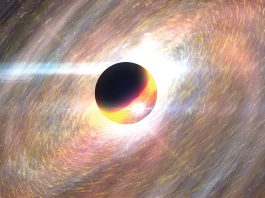Scientists have revealed images of a surprisingly mature primordial galaxy that seems to have formed much quicker than its neighbours.
The primordial galaxy, dubbed ALESS 073.1, appears to have all of the features expected of a much more mature galaxy and has led the team of scientists to question how it grew so fast.
A major goal of present-day astronomy is understanding why different galaxies look the way they do today and when their different components formed. The team, led by scientists at Cardiff University, used the Atacama Large Millimeter/submillimeter Array (ALMA) telescope as a ‘time machine’ to study the remote past, revealing how ALESS 073.1 looked just 1.2 billion years after the Big Bang.
The light emitted from the galaxy took billions of years to reach our telescopes on Earth, the team were able to explore how the galaxy looked during its infancy and determine how it was initially formed. The result was one of the sharpest, direct images of a primordial galaxy ever produced, which allowed the team to undertake a detailed study of its internal structure.
Lead author of the study Dr Federico Lelli, who undertook the work at Cardiff University’s School of Physics and Astronomy, said: “We discovered that a massive bulge, a regular rotating disk, and possibly spiral arms were already in place in this galaxy when the Universe was just 10% of its current age.”
Co-author of the study Dr Timothy Davis, from the School of Physics and Astronomy, said: “This spectacular discovery challenges our current understanding of how galaxies form because we believed these features only arose in “mature” galaxies, not in young ones.”
One key feature of a galaxy is the presence of a so-called bulge – a tightly packed group of stars usually situated within the centre of the galaxy. It was believed that massive bulges formed slowly by the merger of smaller galaxies or by specific processes that occurred within the galaxy itself; however, the kinematic properties of ALESS 073.1 have revealed that the formation of massive bulges can occur extremely fast – around half of the stars in the galaxy were shown to be in a bulge.









